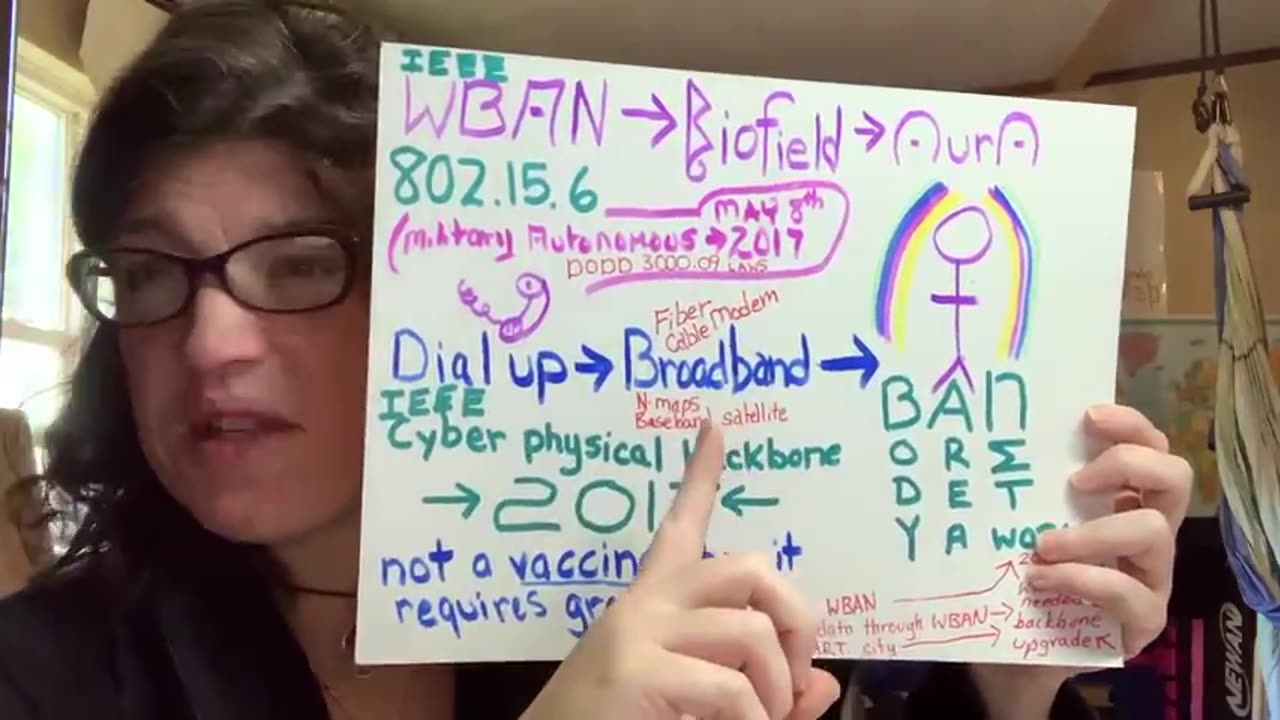Premium Only Content

Sabrina Wallace – CoV-BAN, IoT and WBAN – Computer Networking Through the Human Body
They use Video Game Controllers to play real people like the video game Sims. They are inside our arteries and veins. Modular Open System Approach and Sensors Open System Architecture and OSA is how the Biosensors work with the DSN at the Pentagon.
IEEE – International Standards for Electrical and Electronic Engineers
WBAN - IEEE 802.15.6, IEEE 802.15.4, IEEE 802.15.5.
These work with the Biofield. We used to call it the Human Aura. Now it is called the Wireless Body Areal Network or WBAN.
There are 5 Computer Networking Protocols with algorithms and mathematical schemes of maneuvering the electromagnetic fields of human body.
DARPA - 2012 document says they have ability to do Laparoscopic Surgery from a drone over your home.
1995 - WBAN and MBAN (Medical Body Area Network) - how could all of this been done in 1995? Man, we have been lied to.
Medically Wireless Tissue Engineering - from 2013
HIV was made in Lab by Fauci to disable the immune system. It was just an experiment for what they can do today.
When Sabrina worked at IBM she found an Underground Computer that was connected to a Low Earth Orbiting Satellite that was watching the WBAN.
Graphene Oxide in the body makes communication on the WBAN speed up. They want more data to be able to go through us to prepare for the Smart City Initiatives.
Sabrina says that 80% of your immune system is invisible and wireless and that 80% is the Biofield around you and they know this. This biofield / aura is also responsible for 60% of your Endocrine system.
What organs comprise the Immune System?
1. Thymus
2. Bone Marrow
3. Lymph Nodes
4. Vessels (Vasculature)
5. Spleen
6. Skin
Sabrina says that Celeste Solum has the best overview of Synthetic Biology.
BIL – Brain Image Library – using your biofield with the Wireless Body Area Network.
I am still trying to grasp what Sabrina is saying here, but she goes on to explain how your body is communicating on a Mesh Network. Meaning a network that is connected to other WBAN’s. People connected to people. Bodies communicating with Bodies.
Your biofield is a Node on an Internet Protocol Network that can be accessible to all agencies with PAID access.
Applied Signal Technology – how the signals are transferred.
Our body itself is what is tethered to the cloud.
The tech exists so we would not even need phones, our body would be the phone and would pick up the frequency and be able to transmit the frequency.
Synthetic Telepathy
If your thoughts can be transmitted with you BAN – you can control your smart system with your thoughts. That will be decades away before they bring this in, but the private sector has been doing this for years. I believe a lot of this tech came from the alien contracts and from the Nazi’s in Operation Paperclip.
Once they have transformed what’s left of the human race into controllable little bots, they can make us live for a very long time.
Right now it is easier to hack a human than a car. This technology has been INSIDE our body since the 90’s. According to Sabrina, the covid shots contained the material needed for full connectivity. As the late great Dr. Bill Deagle said back in 2006– they are creating a wireless cage for humanity. That is exactly what they did.
The signals are coming Biophotonically.
They can manipulate the electromagnetic waves.
If you can find this pdf online – I found it last week and downloaded but I forget to save the link, I just remember it took me a half hour of searching to find a free one -- Human Interaction, Emerging Technologies and Future Systems V ( etc.) (Z-Library)
Human and Machine Trust Considerations, Concerns and Constraints for Lethal Autonomous Weapon Systems (LAWS) Guermantes Lailari(B) Strategic and Innovative Group, LLC, Falls Church, VA 22046, USA
Abstract: Trust and autonomous systems, especially weapon systems, could be the most difficult technological challenge facing defense industries, militaries, politicians, and the public because the algorithms have to be trusted. Furthermore, the operator, the military, defense industry, politicians and the public need to trust the system to also follow ethical and legal rules. This paper briefly describes the trust considerations, concerns and constraints regarding autonomous weapons systems and concludes with a brief description of the current development programs and projects by the various US military services.
Page 6 out of this book: Just as military personnel will have to develop and maintain trust in LAWS, trust will also have to be established and maintained throughout the LAWS life cycle, that is, the design, development, deployment, maintenance and upgrades. Interestingly, the Department of Defense Directive (DODD) 3000.09 does not refer to positive outcomes as a design criterion. DoDD 3000.9 defines the goal of autonomous systems as to avoid negative outcomes (“unintended engagement” or experience a “loss of control”) [13]. The lack of a reference in the DODD for a positive outcome for LAWS could be a weakness in the directive and should be reviewed to emphasize administration intent to ensure the weapon system performs as designed. More importantly, the military will have to consider the impact on trust when LAWS does not perform as designed or does have an “unintended engagement” or experiences a “loss of control” [13]; in other words, when LAWS does not perform as designed and breaks trust. By highlighting the unique trust considerations, concerns and constraints between the military person and LAWS, the DOD will be in a better position to provide employment guidance for these systems.
NIST’s Trust and Artificial Intelligence (2021) explains in clear language the AI revolutionary challenge, why trust is so important and difficult to implement: The artificial intelligence (AI) revolution is upon us, with the promise of advances such as driverless cars, smart buildings, automated health diagnostics and improved security monitoring. Many current efforts are aimed to measure system trustworthiness, through measurements of Accuracy, Reliability, and Explainability, among other system characteristics. While these characteristics are necessary, determining that the AI system is trustworthy because it meets its system requirements won’t ensure widespread adoption of AI. It is the user, the human affected by, the AI who ultimately places their trust in the system. The study of trust in automated systems has been a topic of psychological study previously. However, Artificial Intelligence (AI) systems pose unique challenges for user trust. AI systems operate using patterns in massive amounts of data. No longer are we asking automation to do human tasks, we are asking it to do tasks that we can’t. Moreover, AI has the ability to learn and alter its own programming in ways we don’t easily understand. The AI user has to trust the AI because of its complexity and unpredictability, changing the dynamic between user and system into a relationship. Alongside research toward building trustworthy systems, understanding user trust in AI will be necessary in order to achieve the benefits and minimize the risks of this new technology [14] .
**A lot about TRUST. They want everyone to put complete trust in AI.
Sabrina says not only can they read our thoughts, that is old tech.
Sabrina recommends to check out Stefan Burns on Youtube as he explains grounding -- https://www.youtube.com/@StefanBurns
Biophotonic Tools in Cell and Tissue Diagnostics -- https://www.ncbi.nlm.nih.gov/pmc/articles/PMC4656002/ using this since 2007. These are techniques involving the interaction between biological systems and photons.
Video Source: Psinergy – Sabrina Wallace -- https://odysee.com/@psinergy:f
*Note: This is where to go to get Sabrina Wallace PDF’s -- https://t.me/PsinergyPDF
-
 24:49
24:49
Waking the World up
9 hours agoIncredible Video Illustrating Holy Roman Catholic Churches – What Were They Really?
1.43K4 -
 1:36:21
1:36:21
Sarah Westall
5 hours agoViolence Erupting in the Panama Canal, Identifying Enemy Infiltration, Psyops Ongoing w/ Michael Yon
30.1K14 -
 1:56:25
1:56:25
Nerdrotic
8 hours ago $10.43 earnedThe Red Pyramid's Hidden Secrets | Forbidden Frontier #091
44.3K13 -
 2:08:53
2:08:53
vivafrei
16 hours agoEp. 252: Liberals DISQUALIFY Candidate from Race! DOGE Wins & Loses; Rumble Sues BRAZIL! & MORE!
127K215 -
 1:15:12
1:15:12
Josh Pate's College Football Show
7 hours ago $12.96 earnedCFB’s Top 12 Programs | TV Executives & Our Sport | USC Changes Coming | Early Championship Picks
57.5K2 -
 LIVE
LIVE
Vigilant News Network
11 hours agoUK Government BUSTED in Secret Plot to Extract Your Data | Media Blackout
1,437 watching -
 1:03:32
1:03:32
Winston Marshall
3 days ago"War On Children!" The DEMISE Of The West Starts With Schools - Katharine Birbalsingh
107K65 -
 48:02
48:02
Survive History
14 hours ago $5.71 earnedCould You Survive as a Sharpshooter in the Napoleonic Wars?
56.2K3 -
 12:03
12:03
Space Ice
14 hours agoSteven Seagal's China Salesman - Mike Tyson Knocks Him Out - Worst Movie Ever
41K16 -
 11:37
11:37
Degenerate Jay
14 hours ago $12.01 earnedJames Bond Needs Quality Over Quantity From Amazon
80.8K8